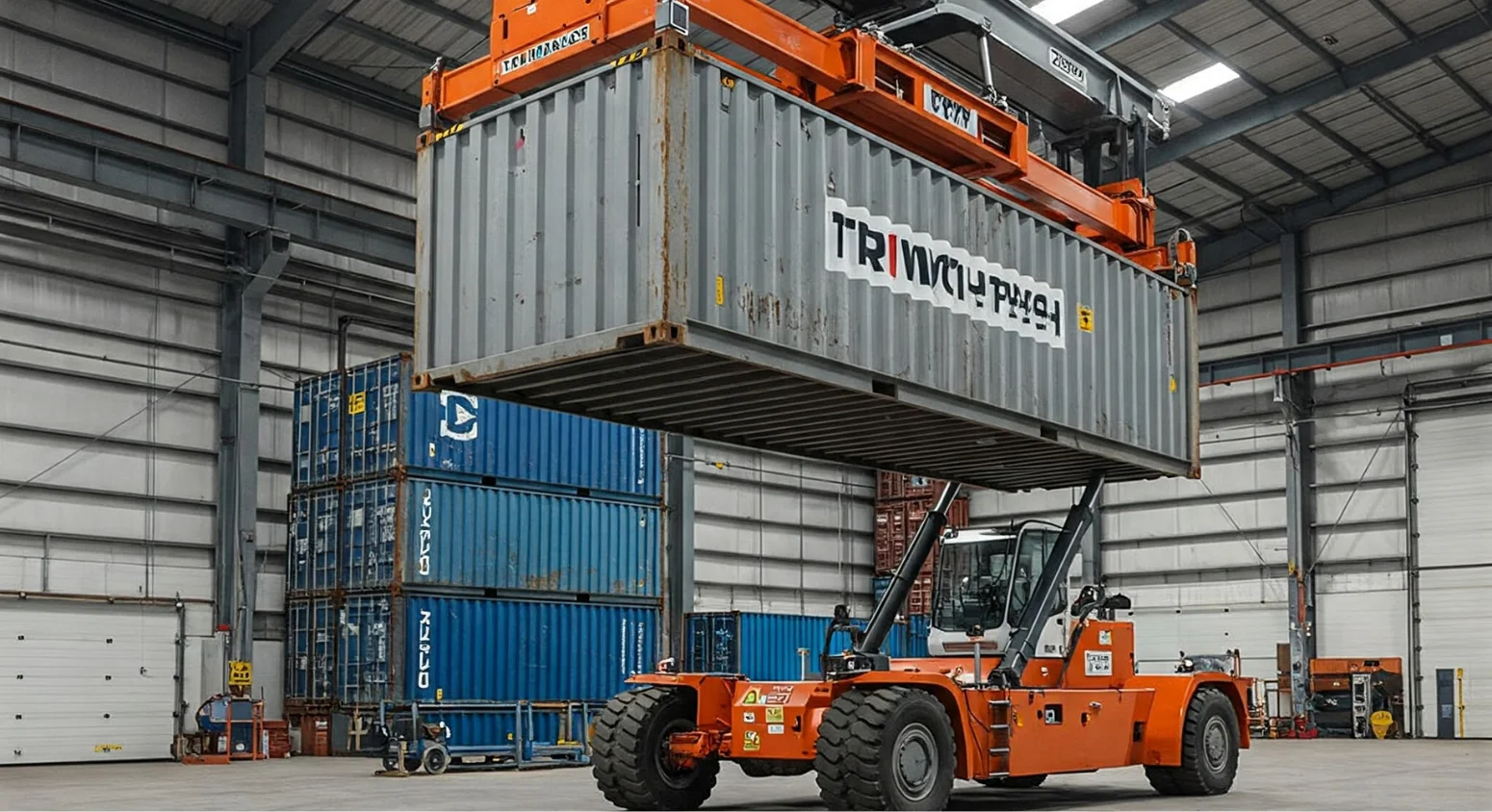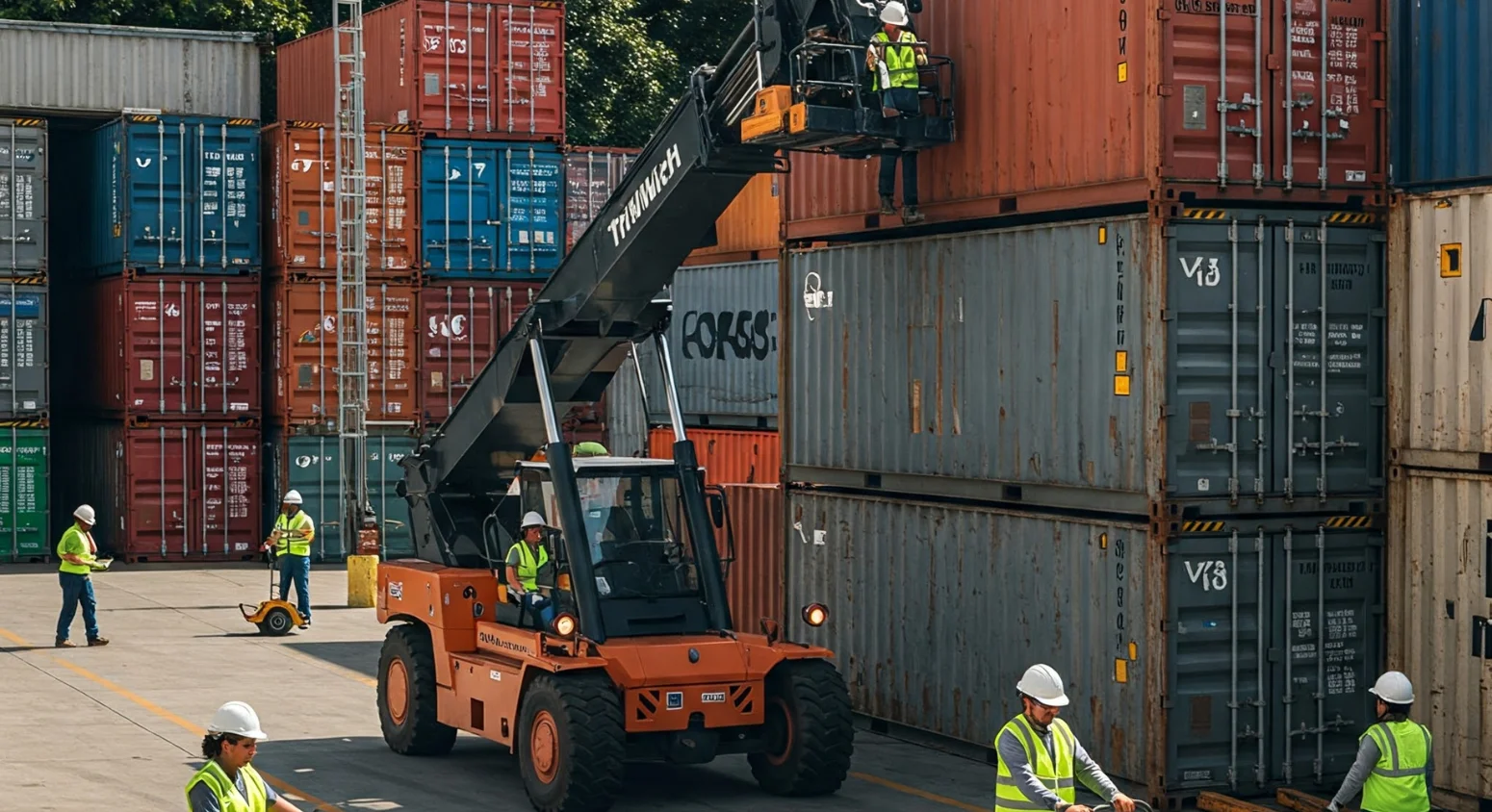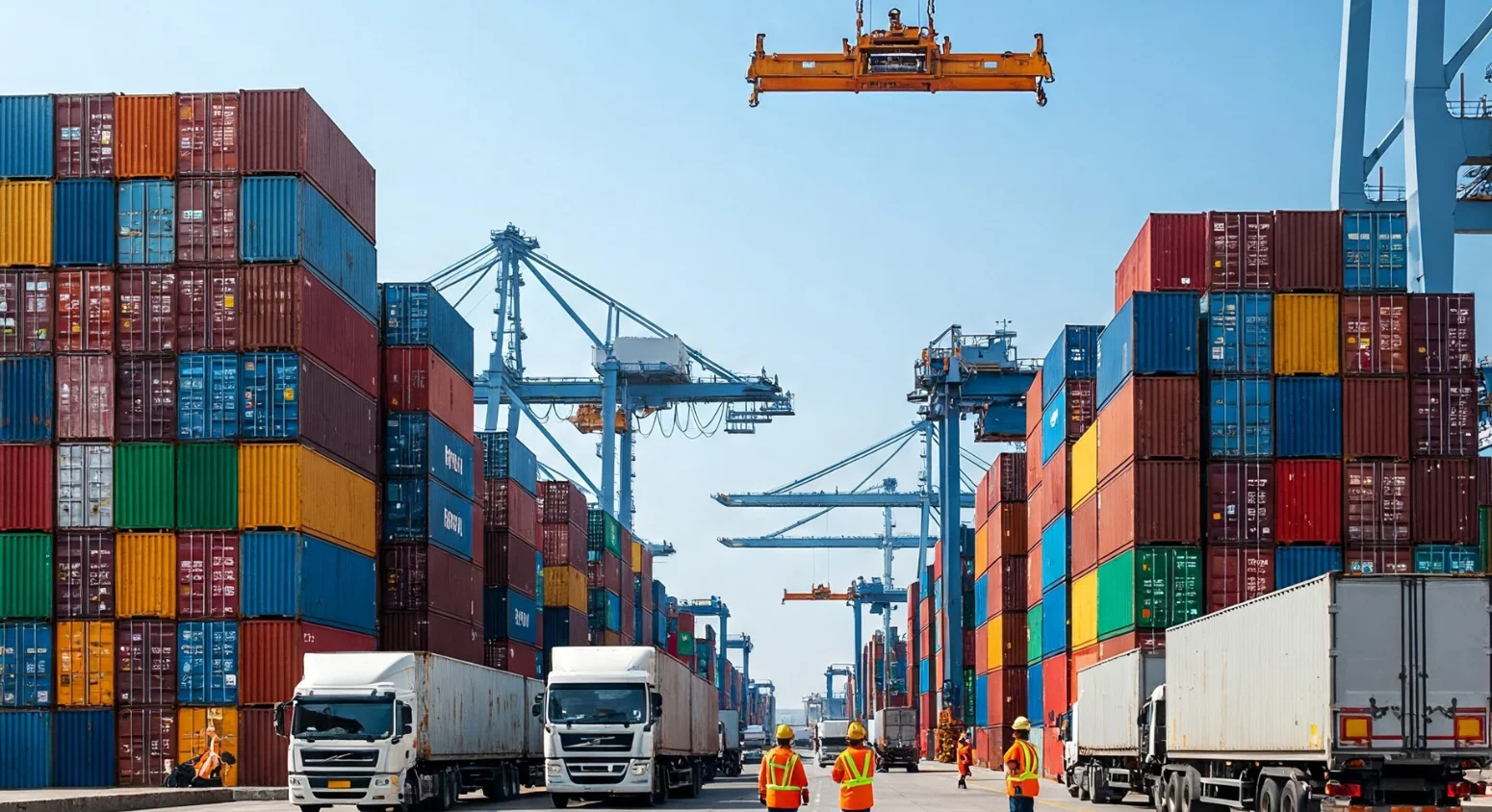Need to move a shipping container but not sure how? Whether you’re relocating a storage unit, setting up a job site, or handling deliveries, moving a container with a truck can seem like a big challenge. Without the right equipment, it can be time-consuming, difficult, and even risky.
Luckily, tools like a shipping container hitch or a shipping container tow hitch make the job much easier. These attachments let you lift and tow containers without needing a crane or heavy machinery. But knowing what equipment to use is just the start—you also need to secure the load properly and follow safe transport methods.
In this guide, we’ll walk you through the entire process, from choosing the right truck to safely loading and moving your container. Whether you’re a contractor, business owner, or tackling a personal project, you’ll learn how to do it the right way—quickly, safely, and without unnecessary hassle. Let’s dive in!
Table of Contents
Understanding the Basics of Moving a Shipping Container
Moving a shipping container isn’t as simple as hooking it up to a truck and driving off. These containers are big, heavy, and not designed to be moved without the right equipment. If you don’t plan properly, the process can be slow, expensive, or even dangerous.
Before you start, it’s important to understand the basics—why you might need to move a container, what challenges you might face, and what type of truck works best for the job.
Why Move a Shipping Container?
Shipping containers aren’t just for transporting goods across the world. People move them for all kinds of reasons, including:
- Storage – Relocating a container used for extra storage.
- Construction sites – Moving on-site offices or tool storage.
- Tiny homes or offices – Transporting container-based buildings.
- Events and pop-up shops – Setting up mobile businesses or exhibits.
No matter the reason, having the right tools and knowledge makes a big difference in how easy (or difficult) the move will be.
Challenges of Moving a Container
Transporting a shipping container with a truck comes with a few obstacles:
- Weight & size – Even an empty container can weigh over 5,000 pounds, and loaded ones can be much heavier.
- Securing the load – If the container isn’t properly fastened, it can shift, tip, or even fall off during transport.
- Tight spaces – Moving a container through narrow areas or rough terrain takes careful planning.
- Legal restrictions – Some areas have weight limits or require special permits for oversized loads.
What Kind of Truck Do You Need?
Not every truck is suited for moving a shipping container. The best choice depends on the size of the container and how far you need to move it. Here are the most common options:
- Pickup Truck – Works for smaller containers when paired with a shipping container tow hitch.
- Flatbed Truck – Carries the container on the truck bed but requires lifting equipment to load it.
- Tilt-Bed Truck – Tilts to slide the container on and off, making loading easier.
- Semi-Truck with Container Chassis – Used for hauling standard 20ft or 40ft containers over long distances.
Choosing the right truck is key to making sure the move is safe and efficient.
Tools You Need to Lift and Move a Container
Before attaching a container to your truck, you’ll need tools to help with lifting and positioning. Some of the most useful ones include:
- Container lifting jacks – Raise the container high enough to attach it to a truck or trailer.
- Shipping container dollies – Help roll the container into position before transport.
- Heavy-duty wheel dollies – Make it easier to move containers over short distances.
Understanding these basics will help you plan a smooth and hassle-free move. Next, we’ll cover the essential equipment that makes container transport even easier.
Essential Equipment for Moving Containers with a Truck
Moving a shipping container isn’t just about having a truck—it’s about having the right tools to lift, secure, and transport it safely. Without the proper equipment, you risk damaging the container, the truck, or even the road. So, what gear do you actually need to make the process smooth and efficient?
The Must-Have Tools for Container Lifting and Transport
Before you attach a container to your truck, you need a way to lift and position it properly. Here are some key tools that can help:
- Container lifting jacks – These powerful tools raise the container high enough so you can slide a trailer or hitch underneath. If you’re working alone or in a small team, lifting jacks can make the job much easier.
- Shipping container dollies – Ideal for rolling a container short distances, especially in tight spaces where a truck might not fit.
- Heavy-duty wheel dollies – If you’re dealing with rough or uneven terrain, these sturdy dollies can help maneuver the container safely.
- Shipping container tow hitch – Attaches to the container and allows it to be towed behind a capable vehicle, like a pickup truck.
Why HitchWich is a Game-Changer for Truck-Based Container Moves
One of the best tools for moving containers with a truck is a shipping container hitch, like the HitchWich. It eliminates the need for cranes or forklifts by allowing trucks to lift and tow containers directly.
Here’s why a HitchWich can make a huge difference:
- Simple & Efficient – No need for complex lifting systems or extra hands. Just attach, lift, and tow.
- Versatile – Works with various truck types, making it a flexible option for different container sizes.
- Cost-Effective – Cuts down on expensive rental fees for heavy-duty lifting equipment.
- Safe & Secure – Reduces the risk of load shifting or instability during transport.
Additional Gear for Safe Transport
Once the container is lifted and attached to the truck, securing it is the next critical step. You’ll want to have:
- Ratchet straps & chains – These ensure the container stays firmly in place during transit.
- Corner locks & twist locks – Provide extra stability for containers mounted on trailers.
- Reflective markers & safety flags – Help with visibility, especially for oversized loads.
Investing in the Right Equipment Saves Time & Money
Using the right tools isn’t just about safety—it also saves you from unnecessary headaches. With the right lifting jacks, shipping container tow hitches, and heavy-duty wheel dollies, you can move containers faster, with less effort, and without needing extra manpower.
Now that we’ve covered the essential equipment, let’s dive into the step-by-step process of moving a container with a truck.
Step-by-Step Guide to Moving a Container with a Truck
Now that you have the right equipment, it’s time to move your shipping container. Whether you’re hauling a loaded container across town or simply repositioning an empty one, following the correct steps will save you time, prevent damage, and keep you safe.
Step 1: Preparing the Container for Transport
Before you even touch the truck, make sure your container is ready to move.
- Check the weight – An empty 20-foot container weighs around 5,000 pounds, while a loaded one can be much heavier. Ensure your truck and equipment can handle the load.
- Inspect the container – Look for structural damage, rusted corners, or weak spots that could cause problems during transport.
- Clear the path – Make sure there’s enough space to lift and maneuver the container without obstacles.
Step 2: Lifting the Container
Since shipping containers sit directly on the ground, you’ll need to lift them before attaching them to your truck. There are a few ways to do this:
- Using container lifting jacks – These tools raise the container high enough to attach a trailer or a shipping container tow hitch.
- Placing the container on shipping container dollies – Ideal for short-distance moves or when maneuvering in tight spaces.
- Attaching heavy-duty wheel dollies – If you’re rolling the container over uneven terrain, a vehicle wheel dolly can help stabilize and support the load.
Step 3: Securing the Container to the Truck
Once the container is lifted, it’s time to attach it securely.
- Use a shipping container tow hitch – This specialized hitch connects directly to the container, allowing it to be towed safely behind a truck.
- Lock it in place – Use heavy-duty straps or twist locks to keep the container from shifting.
- Double-check the balance – Ensure the weight is evenly distributed to prevent swaying or tipping.
Step 4: Driving Safely with a Container Load
Driving with a container requires extra caution. Here’s what to keep in mind:
- Accelerate and brake slowly – A heavy load takes longer to stop, so allow extra distance.
- Take wide turns – Containers extend behind the truck, so you’ll need more space when turning.
- Watch for height restrictions – Standard containers are about 8.5 feet tall, so be mindful of bridges and overpasses.
Step 5: Unloading the Container at Its Destination
Once you reach your destination, safely unloading the container is just as important as getting it there.
- Find level ground – Placing the container on an uneven surface can cause it to tip or shift.
- Slowly lower using jacks or dollies – If you used container lifting jacks or wheel dollies, carefully bring the container down.
- Check for movement – Before unhooking, make sure the container won’t roll or slide unexpectedly.
Safety and Legal Considerations for Moving a Shipping Container
Moving a shipping container isn’t just about having the right truck and equipment—it’s also about doing it safely and legally. A poorly secured load or an overloaded vehicle can lead to accidents, fines, or even damage to roads and property. To avoid these risks, it’s important to follow safety guidelines and understand local transport laws.
Safety Tips for Moving a Shipping Container
Handling a heavy container comes with risks, so taking the right precautions is a must. Here’s how to keep yourself and others safe during transport:
- Inspect your equipment – Before lifting or towing, check your shipping container jack, tow hitch, and wheel dollies for any signs of wear or damage. Faulty equipment can lead to accidents.
- Distribute weight evenly – An unbalanced container can shift during transport, making the truck harder to control. Ensure that the weight is evenly spread inside the container.
- Use proper securing methods – Ratchet straps, twist locks, or container chains are essential to keep the load stable and prevent movement while driving.
- Check tire pressure and truck capacity – Overloading your truck or using low-pressure tires can reduce braking efficiency and increase the risk of tire blowouts.
- Drive cautiously – Since containers add significant weight and length to your vehicle, be mindful of braking distances, turns, and speed limits.
Legal Requirements for Container Transport
Every region has its own rules for hauling large and heavy loads, so it’s important to check your local regulations before hitting the road. Some common legal requirements include:
- Weight and size limits – Many places have restrictions on how much weight a truck can carry. If your container is loaded, you might need a permit for oversized or overweight loads.
- Towing laws – If you’re using a shipping container tow bar or hitch, ensure it meets towing regulations for your vehicle’s weight class.
- Permit requirements – Some areas require special permits for moving large cargo, especially on highways or through city streets.
- Lighting and signage – If your container extends beyond the truck bed, you may need reflective markers, safety flags, or additional lights to comply with road safety laws.
Common Mistakes to Avoid
Even experienced drivers can make mistakes when moving a shipping container. Here are some common errors to watch out for:
- Not checking clearance heights – Standard containers are around 8.5 feet tall, but high-cube models are even taller. Low bridges and tunnels can be a major hazard.
- Ignoring road conditions – Rough terrain, steep slopes, and sharp turns can be challenging when towing a heavy load. Plan your route ahead of time.
- Skipping the weight check – If you don’t verify the container’s weight, you could exceed your truck’s towing capacity, which can lead to mechanical failure.
- Forgetting about braking distance – A fully loaded container significantly increases stopping distance, so always keep extra space between your truck and other vehicles.
Play It Safe & Stay Legal
Moving a container the right way isn’t just about efficiency—it’s about ensuring a safe and legal transport. By following these safety guidelines and checking local transport laws, you can avoid costly mistakes and make your move as smooth as possible.
Now that you know how to handle the legal and safety aspects, let’s wrap things up with some final thoughts on making your container move easier and more efficient.
Making Container Transport More Efficient with the Right Tools
Moving a shipping container with a truck doesn’t have to be a stressful or time-consuming task. By choosing the right equipment and strategies, you can save time, reduce costs, and improve overall efficiency. Whether you’re transporting a container for work, storage, or relocation, using purpose-built tools can make a huge difference.
Why the Right Equipment Matters
The right tools don’t just make the job easier—they also:
- Improve safety – Reducing the risk of accidents, shifting loads, or damage to your truck.
- Save time – A properly equipped setup means less manual labor and faster transport.
- Cut costs – Investing in quality tools like shipping container dollies and container lifting jacks can reduce reliance on expensive heavy machinery.
Top Tools for Faster and Easier Container Moves
If you want to move your container efficiently, consider using these specialized tools:
- Shipping Container Tow Hitch – Attaches directly to your truck, allowing for easy towing without needing a trailer.
- Vehicle Wheel Dollies – Help maneuver containers in tight spaces before and after transport.
- Container Lifting Jacks – Make lifting and lowering the container onto a truck or trailer simple and safe.
- Heavy-Duty Wheel Dolly – Provides additional support when moving a container over uneven ground.
How HitchWich and Wheel Dollies Streamline the Process
Two of the most effective tools for truck-based container transport are HitchWich and Wheel Dollies.
- HitchWich: This innovative shipping container hitch allows you to lift and tow a container directly with your truck, eliminating the need for cranes or forklifts. It’s ideal for quick and cost-effective moves.
- Wheel Dollies: Whether you’re using automotive wheel dollies for smooth surfaces or heavy-duty off-road casters for rugged terrain, these tools make repositioning containers much easier.
Pro Tips for Maximum Efficiency
Want to make your move even smoother? Keep these tips in mind:
- Plan your route ahead of time – Avoid low bridges, weight-restricted roads, or difficult terrain.
- Use high-quality securing gear – Ratchet straps, twist locks, and reinforced hitches will keep the container stable.
- Work smarter, not harder – Instead of relying on manual labor, use tools like container jacks and tow hitches to simplify the process.
Move Containers Smarter, Not Harder
Efficiency in container transport comes down to having the right tools and a solid plan. By using HitchWich, Wheel Dollies, and other specialized equipment, you can move containers faster, safer, and with less effort.
Now that we’ve covered the best tools and strategies, let’s wrap up with some key takeaways to ensure your next container move is a success.
Final Thoughts: Moving Containers the Right Way
Transporting a shipping container with a truck may seem like a big challenge, but with the right approach and equipment, it can be a smooth and efficient process. Whether you’re relocating storage units, delivering cargo, or setting up a mobile workspace, knowing how to properly lift, secure, and transport a container is crucial.
By using tools like HitchWich, container lifting jacks, and shipping container dollies, you can significantly cut down on manual labor, improve safety, and move containers more efficiently. A shipping container tow hitch makes towing easier, while wheel dollies help maneuver containers into position with minimal effort. When combined with proper safety precautions and legal compliance, these tools ensure a hassle-free move.
Now, as you prepare for your next container transport, ask yourself: Do you have the right equipment? Have you checked weight limits and legal requirements? Planning ahead and choosing the best tools will save you time, money, and stress.
Still have questions? Here are some frequently asked ones to help clarify the process.
Frequently Asked Questions
How can I ensure the safety of my container during transportation?
To ensure the safety of your container during transportation, make sure it is properly secured to the truck using appropriate fastening mechanisms and padding to prevent shifting. Choose a reputable transport company with experience in handling containers safely.
What are some innovative solutions available for moving containers?
Innovative solutions for moving containers include using specialized equipment like self-loading trailers, automated cranes, and GPS tracking systems for real-time monitoring. These technologies streamline the moving process, improve efficiency, and enhance overall safety and security of container transportation.
How should I prepare my container for transportation?
Before transporting your container, make sure it is clean, free of any debris or hazardous materials, and properly sealed. Inspect the container for any damages that could affect its structural integrity during transportation, and secure any loose items inside to prevent shifting.
What factors should I consider when selecting a transport method for moving a container?
When selecting a transport method for moving a container, consider factors such as the distance of transportation, size and weight of the container, terrain conditions, cost-effectiveness, and time constraints. Choose a method that best suits your specific needs and ensures the safe delivery of your container.
Can I load and unload the container myself or do I need professional assistance?
While you may be able to load and unload the container yourself if you have the necessary equipment and expertise, it is recommended to seek professional assistance. Professional movers have the experience and tools required to safely load and unload containers, minimizing the risk of damage or accidents.



